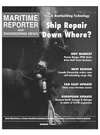
Page 32: of Maritime Reporter Magazine (August 1996)
Read this page in Pdf, Flash or Html5 edition of August 1996 Maritime Reporter Magazine
ship & boatbuilding technology
division p Undersea propeller
repair is offered
anywhere by \
Engineering A Solution
Key to the team's success has been the
development of equipment which makes it
possible to straighten major propeller
bends, as well as equipment designed to
dramatically shorten the time it takes to
cut and grind blades.
In addition, specialized equipment and
techniques were developed which enabled
Lips technicians to measure propeller
geometry underwater, reportedly with
degrees of accuracy comparable to onshore
shops. Of course, every propeller cannot be
straightened, as cold straightening to class
standards is only possible when there is no
associated cracking. But Lips believes its
specialized training provides an advantage,
as its team is capable of looking for and
evaluating any additional defects.
For more information on Lips Subsea
Circle 103 on Reader Service Card
SMOOTH SAILING
Problem: A cruise ship in Alaska encounters
ice, and one of its highly skewed, four-blade
props is bent aft eight in., with the bend extend-
ing 20 in. into the section.
Standard Solution: Cut off both the dam-
aged blade and the opposite, undamaged blade,
so as to restore mass balance. This decreases
speed, increases fuel costs, and increases later
repair costs.
Lips Subsea Solution: At 9:30 a.m., Lips
engineers enter the water, and confirm the bend
is free of cracks. A half-hour later, a straighten-
ing device is lowered into place. By 11:00 a.m.,
the Lips technician has straightened the bend and
inspected the blade to confirm that there are no
new cracks. That evening, the ship sails as sched-
uled. with normal propeller vibration reported.
Vast opportunities for Gulf Coast
Kimo Mackey is a busy guy.
He, and his "SWAT" team of divers are ready at
a moment's notice to respond to calls from
shipowners and operators around the world,
answering the calls for help with a complete pro-
peller repair solution.
Mr. Mackey would have it no other way.
Lips Subsea — based in Poulsbo, Wash. — was
formed to provide a quick, correct and cost-effec-
tive solution to propeller damage. The underwa-
ter repair team can be most anywhere in the
world within 48 hours, and it provides services
consistent with each individual situation.
The team promises to deliver most any major
propeller repair work, including the straighten-
ing of major bends. The company reports that the
repairs are often considered by the major class
societies to be 100 percent complete.
Even the most seasoned owner/operator knows
that pulling a ship from service for repairs is a
trying time — both mentally and financially.
Lost time equals lost business, and coupled with
escalating repair costs and razor-thin margins
prevalent in the industry today, the event can
lead to real financial disaster. Propeller damage
seems to be particularly prevalent in the Pacific
Northwest of the U.S., a factor which led to the
base of the company.
(Continued from page 29)
increased demand for drilling in deeper water, the market for semi-
submersible conversions has exploded, and big rig yards are now look-
ing at backlogs of projects that extend into late summer of 1997," said
Mr. Covington.
Peter Husta, director, Sales and Marketing, for Service Marine
Industries, Inc., reports similar offshore conditions. The activities in
the Gulf of Mexico are increasing significantly, as evidenced by the
number of working platforms and rigs in use and currently under
mobilization. As of early June, 63 of the 77 Gulf platform rigs were
working under contract, according to Mr. Husta.
"Our customers are busy supporting drilling activities in progres-
sively deeper waters. They are also being called upon to support dif-
ferent types of activities which require them to reconfigure their ships
to meet the specific needs of the oil, drilling or seismic survey compa-
ny. This level of activity is much higher than we've seen in the past
three to five years," said Mr. Husta.
34 Maritime Reporter,Engineering News
Pictured is an illustration of 4-D, one of the new information technology services provided
by Western Geophysical. The objective of this service is to provide oil and gas compa-
nies with a detailed reservoir model which allows identification of subtle changes in fluid
content.
New Technologies Spawn New Business
According to Mr. Koerber of Western Atlas, three major technolo-
gies have enabled oil companies to reduce their finding costs so much
that the actual block price is less of an issue compared with three to
five years ago. These technologies are: 3-D seismic, which cuts costs

 31
31

 33
33
